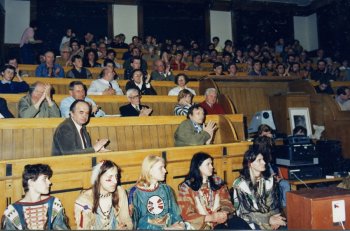Curator: Veronika Resslová
Wenn man doch ein Indianer wäre, gleich bereit, und auf dem rennenden Pferde, schieß in der Luft, immer wieder kurz erzitterte über dem zitternden Boden, bis man die Sporen ließ, denn es gab keine Sporen, bis man die Zügel wegwarf, denn es gab keine Zügel, und kaum das Land vor sich als glattgemähte Heide sah, schon ohne Pferdehals und Pferdekopf. (1)
This exhibition examines the lives of a minor group of Czech dissidents — the subculture of the so-called Czech Indians — which sprung up at the very end of the socialist regime, in tribal and personal chronicles. Such chronicles did not record their camps and the human stories that took place in any systematic way, as the camera was not usually found among the equipment of Czech Indian camper. Instead, these fragments appear as random, sometimes achronological, images, records, documents, and notes written by various authors. There are also a few amateur video documentaries which survive from the early 90s.
The North American Indian style of camping from that time in the Czech region finds itself somewhere at the intersection of so-called living history and experimental archeology. But living history, a specific kind of practice that attempts to revive a specific historical period, here extended into the daily urban life of the participants, outside their camps, and was transformed into a specific lifestyle as part of a nonintellectual underground movement. Here, such traditional North American Indian elements as the respect for human individuality, the community way of life, nature, and the aura of self-produced objects for daily use comes together with a kind of Indian hobbyism as a means of escape from the surrounding normalized society.
Some signs of the practice of camping in the North American Indian style began to appear in the Czech Republic already in around the First World War. There are reports already in 1911 that one of the first Indian tepees stood at Brdy, and the nicknames in use by the tramps there and the names of their cabins often were Indian in character. The romantic image of the free North American Indian, a specific European notion of the “noble savage”, uncorrupted by civilization, resurfaces during critical periods, corresponding to the oppressed Czech national identity under different cultural circumstances, whether in the period before the establishment of the independent republic (e.g., M. and J. Aleš[2], J.V. Sládek[3], F. Kafka[4]) or after 1968 (e.g., J. Brabec[5], J. Topol[6]). The phenomenon of camping in the North American Indian style extended also to the former GDR, Hungary, Poland and Russia (undoubtedly influenced by the adventure novels of Karl May, which were accepted by the socialist regime, and especially by their popular film adaptations from the 60s). Members of the Indian subculture were constantly monitored by the state police in the GDR, and although they were not under constant supervision, the camps were randomly checked and minor clashes over style of clothing were quite common in Czechoslovakia.
The first group meeting of Indian campers began to be organized in the 70s in the northern Czechoslovakia (in a region well known for producing the glass beads used by North American Indians in their decorative work). “Beads were collected from dumps around Jablonec nad Nisou, and for deer leather (understood to be tanned leather), we waited in queues in the drug stores. Canvas for tepees was purchased wherever possible, and books and the other materials were a real treasure.”[7] In the 80s, a few Czech and Moravian Indian tribes arose (in 1991 the membership list of Westerners International had 10 tribes, and along with other members ICWI there were roughly 130 people), among which was the legendary Prague tribe the White Wampum, well known for its orthodox style of camping and uncompromising use of very authentic materials and techniques. From 1986, the tradition of meeting in the North was followed by establishing traditional meetings in western Czechoslovakia, near Karlovy Vary. The period shortly before the collapse of the socialist regime became the period of the largest expansion of the Indian subculture in Bohemia. After the end of the regime, it became possible to travel abroad to visit North American Indians, some of whom also travelled to the Czech Republic, and to establish contacts with other “Euroindian” groups. But at this time, the whole Czech Indian subculture split. Part of the core groups shed their anti-regime and anti-consumer orientation, instead focusing more on material issues,such as trading in goods for hobbysts.
The photos were taken from the chronicles of White wampum, Čikala and Tazi.
Thanks to Wabaša, Čikala, Tazi, Tonweya and Ištawin for help in preparing the exhibition and for providing the materials used, and for technical support to Martin Blažíček.
(1), (4) If one were only an Indian, instantly alert, and on a racing horse, leaning against the wind, kept on quivering jerkily over the quivering ground, until one shed one’s spurs, for there needed no spurs, threw away the reins, for there needed no reins, and hardly saw that the land before one was smoothly shorn heath when horse’s neck and head would be already gone. (Franz Kafka, The wish to be a red Indian, 1913)
(2) Trapper & Boa – Osudová dobrodružství Jana a Mikoláše Alše / kurátor: Ondřej Chrobák / AJG: Wortnerův dům /České Budějovice / 12. 12. 2013 – 2. 2. 2014
(3) J.V. Sládek, Na hrobech indiánských, 1875
(5) Indiáni milujou hory, Domácí kapela, 1988
(6) J. Topol, Trnová dívka, Torst, Praha1997
(7) Čikala, Zpráva o českých indiánech, Dotek, str. 20- 22, (?)


